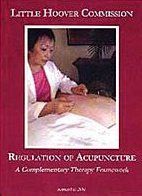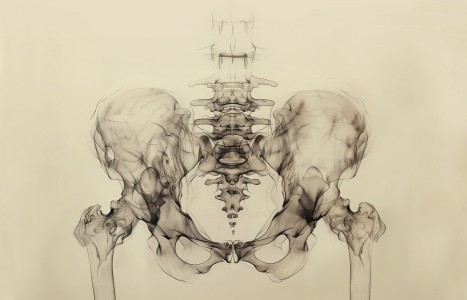People today want convenience, whether it be from their bank, credit card, favorite retail store, or restaurant. They demand it from the companies who hold their loyalty, including their health care providers (you). They don’t want to call and possibly be put on hold, and they want to use an app or schedule an appointment on your website. Here are three reasons your practice can gain by switching to online appointment scheduling.
Little Hoover Commission Publishes Analysis of Acupuncture Profession
In September 2002, then-Governor Gray Davis signed into law Senate Bill 1951 and Assembly Bill 1943, two pieces of legislation that, among other things, extended the life of the California Acupuncture Board (CAB) through July 1, 2005; altered the structure of the board's membership; and mandated all California schools that offer programs in acupuncture "shall include a minimum of 3,000 hours of study in curriculum pertaining to the practice of an acupuncturist" in order for the school to receive CAB approval.1,2
In addition to these provisions, both bills mandated that a little-known government agency, the Milton Marks Commission on California State Government Organization and Economy (also known as the "Little Hoover" Commission), conduct an analysis of the acupuncture profession in California. Specifically, the bills requested that the commission review and make recommendations on the scope of practice and educational requirements for acupuncturists; evaluate the National Certification Commission for Acupuncture and Oriental Medicine's (NCCAOM) national certification exam and make recommendations as to whether the NCCAOM's exam should be offered as part of, or a replacement for, California's own certifying exam; and evaluate and make recommendations on the approval process of the CAB, the Accreditation Commission for Acupuncture and Oriental Medicine (ACAOM), and the Bureau for Private Postsecondary Education.

The Little Hoover Commission was required to provide its findings to the Legislature by Sept. 1, 2004. The result of the commission's work is a newly published report, Regulation of Acupuncture: A Complementary Therapy Framework, which makes several far-reaching observations about the current state of the profession, and is sure to affect the practice of acupuncture in California for years to come.
To accomplish its mission, the commission held a series of advisory committee meetings and public hearings between August and October 2003. During these meetings, the commission received written and oral testimony from licensed acupuncturists and CAB members on matters pertaining to licensure, the competency of practitioners, curriculum hours, the role of regulatory agencies, protecting the public, and other issues. Representatives from several state and national organizations also provided input, including officials from NCCAOM, ACAOM, the Council of Colleges of Acupuncture and Oriental Medicine (CCAOM), the Council of Acupuncture and Oriental Medicine Associations, the California State Oriental Medical Association, the National Guild for Acupuncture and Oriental Medicine, and the National Board of Acupuncture Orthopedics.
In addition to the public meetings, the commission received several reports on the profession from the University of California at San Francisco, California State University, Sacramento, and the RAND Corporation.
After gathering the information presented to it, the commission spent several months analyzing the data before issuing its report. The completed version of Regulation of Acupuncture contains a total of six relevant findings, each relating to an individual component of the profession. Along with the findings, the report offers a series of recommendations the commission believes will help define and strengthen the profession, thereby improving the practice of acupuncture and providing California's citizens with competent, highly-trained health care providers. A review of the commission's findings and recommendations is presented below.
Findings and Recommendations
Finding #1: While the legal scope of practice clearly defines the modalities that acupuncturists can use, the statue is silent on issues that are important in defining their role as health care providers.
Existing California law clearly states which treatments acupuncturists may use. However, it does not give them the authority to diagnose patients, nor does it place any limits on the conditions acupuncturists may treat. Legal opinions, not changes to the state's Business and Professions Code, have expanded the scope of practice for acupuncturists to the degree that they are now allowed to perform exams and procedures that may not be allowed in other states, including X-rays, blood tests, MRIs and other types of care. This combination of law and opinion has resulted, in the view of the commission, in a "murky legal framework" that "has the potential to confuse the public about the capacity of acupuncturists, and could potentially compromise public health."
Recommendation: The governor and the Legislature should clarify in statue the role of acupuncturists in the health care system. Specifically, the statute should:
- Keep licensure focused on traditional Oriental medicine. The statue should clarify that licensure is for the practice of traditional Oriental medicine as an alternative and complement to Western medicine.
- Define "primary care practitioner." The statute should make it clear that acupuncturists are primary care practitioners within the context of traditional Oriental medicine.
- Authorize and define "traditional Oriental diagnosis." The scope of practice should be modified to specifically authorize acupuncturists to conduct a traditional Oriental diagnosis, and provide a definition of that term.
- Require disclosure of critical information. Patients should receive information on the benefits of coordinating care with medical doctors, and should receive safety precautions on subjects such as disposable needles, herb-drug interactions and the contamination of herbal products.
- Allow for acupuncture-only licensure. A separate category of licensure should be created for professionals who provide only acupuncture, and not the fully array of traditional Oriental medicine. To accomplish this, a reduced educational curriculum and licensing exam would have to be developed and implemented.
Finding #2: The new 3,000-hour educational requirement is adequate to prepare entry-level practitioners and to protect the public safety.
Effective Jan. 1, 2005, new students enrolled in an acupuncture program in California must complete a minimum of 3,000 hours in training before being allowed to take the state's licensure examination. The reason for the increase remains a hotly contested issue. Some state associations and individual acupuncturists have put forth the position that the increase in hours is critical to patient safety, and is part of a long-term goal to raise the training and professional standing of acupuncturists to that of Western medical doctors. The Department of Consumer Affairs has countered that increases in license requirements - such as an increase in the hours of training - should be tied to the profession's scope of practice as defined by law.
Based on those standards, the commission believes there is "no evidence to support the need to further increase the educational requirements." Furthermore, information provided by the University of California at San Francisco and others suggests that "implementing the new requirements will be difficult for some schools, and may result in fewer schools generating fewer students eligible to take the California exam.
Recommendation: The number of educational hours should not be increased, and should be focused on traditional Oriental healing practices within a modern framework for patient safety. Specifically, the California Acupuncture Board should implement the following policies:
- Educate within scope. Required courses for licensed acupuncturists should only be for subject matter needed to safely and competently practice the legal scope of practice.
- Devote adequate curriculum to patient safety, including coordination. Once the new curriculum has been implemented, an independent evaluation should be conducted to ensure that concerns about minimum training needs are met, with special attention given to training regarding patient safety.
- Teach within area of expertise. Courses in physiology, chemistry, biology and other sciences should be taken at schools accredited to grant degrees in those areas of study. As a separate issue, the CAB should consider making successful completion of basic science courses a prerequisite to beginning training at an Oriental medicine school.
Finding #3: The steadily increasing educational requirements for new entrants into the acupuncture profession potentially creates different levels of competency, and could confuse or mislead the public regarding the knowledge, skills and ability of those previously licensed.
Current CAB regulations require acupuncturists to undergo 30 hours of continuing education every two years. However, many acupuncturists currently practicing in California have only 1,350 hours of training, and were licensed prior to the time when they could practice independently of medical doctors and were allowed to diagnose patients. In addition, approximately 900 acupuncturists who were licensed in the mid- 1970s or "grandfathered" into licensure will be practicing with considerably less formal training than most recently licensed practitioners. This has created several levels of educational "unevenness" among practicing acupuncturists, which could compromise public safety.
Based on this situation, the commission feels that "it is difficult to accept that new students should receive additional training on issues directed at improving patient safety without requiring current licensees to receive at least some of that training in a meaningful way," and suggests that regulatory agencies ensure patient safety is incorporated into the practices of all acupuncturists regardless of the amount of time they have been in practice.
Recommendation: The governor and the Legislature should reallocate - and consider increasing the number of - continuing education hours required of currently licensed practitioners as a mechanism to update patient safety requirements. The law should:
- Specify courses. The CAB should identify courses and training necessary to keep practitioners up-to-date on "red flag" conditions, emergency procedures and other issues relevant to patient safety.
- Require examination. The state should require testing for materials related to patient safety.
Finding #4: The examination of candidates for licensure is a critical quality control measure for assuring competency of providers, and is an essential mechanism for ensuring that evolving public policy goals are met.
One of the biggest issues facing California's acupuncturists has to do with the examination required for licensure. While most health care providers in California are licensed based on the passage of a national examination, and while most acupuncturists in the U.S. receive licensure based on the NCCAOM's certifying exam, California has its own licensing exam for acupuncturists.
In the past few years, the question of whether to replace California's licensing exam with the NCCAOM's exam has become the subject of much debate. After analyzing both exams, the commission has concluded: "... while both the California and national examinations are statistically sound and meet all other measures of quality, the California examination was somewhat more robust." However, they feel that the California exam "does need to be refined to ensure that critical knowledge is tested and passed."
Recommendation: The California Acupuncture Board should continue to control its examination to ensure that the state's policy goals are met. Among the policy goals that the state should ensure:
- Demonstrate knowledge of critical components of safe practice. The exam should include "must-pass" modules for areas of concern such as herb-drug interactions, administration of single-use needles, ways to control infections and infectious diseases, and when (and how) to refer to medical doctors.
- Competitive examination administration. The CAB should continue to contract out for the secure administration of the licensing exam.
- Develop strategy for implementing internship. A strategy for proving the practical skills necessary to be successful in practice should replace the (discontinued) practical portion of the examination.
Finding #5: The process used by the Accreditation Commission of Acupuncture and Oriental Medicine appears to be superior to the school process used by the acupuncture board, and could be used by the state to ensure the quality of education for potential licensees.
In order to sit for the California licensing exam, a potential licensee must graduate from a school approved by both the CAB and either the state's Bureau of Private Postsecondary and Vocational Education or a similar bureau in another state. Most acupuncture schools seek accreditation from ACAOM; in fact, every other state that licenses acupuncturists in the U.S. relies on ACAOM to ensure the quality of acupuncture schools. California is the only state that has its own school approval process.
The commission is of the opinion that, compared to California, "ACAOM's process appears to be more rigorous and appears to put more focus on improving the quality of education over time." In addition, ACAOM has an established process for reviewing accredited schools to ensure they continue to meet certain standards; California doesn't. By relying on ACAOM to assess schools, the commission believes the acupuncture board could devote more time and resources to other important issues.
Recommendation: California should rely on ACAOM to accredit acupuncture schools, and other institutions for accreditation that are recognized by the Secretary of Education, while developing a mechanism to ensure that state-specific curriculum standards are met. To achieve that goal, policy-makers have two options:
- Contract with ACAOM. California could establish a memorandum of understanding with ACAOM to verify that requirements specific to California are met by individual schools, and that aggregated information is made public.
- Require schools to document. The state could require schools to document that they have met any California-specific legal requirements that exceed national accrediting standards. This requirement already exists in California for schools of podiatry.
Finding #6: The California Acupuncture Board has missed significant opportunities to protect the public, particularly in the areas of consumer information and herb-related safety.
The commission saved some of its harshest criticism for the California Acupuncture Board, the state's regulatory agency, blaming it for many of the problems the profession currently faces.
"Many of the specific issues that the governor and the legislature asked the commission to review have festered because the acupuncture board too frequently acted as a venue for promoting rather than regulating the profession," the commission observed. "As a result, the board has missed opportunities to protect the public by providing accurate and complete information about the therapies that licensees can provide. The board also has not adequately incorporated emerging scientific evidence into board policies, regulations and public communications."
Recommendation: The governor and the Legislature, through the sunset review process or other mechanisms, should ensure that the California Acupuncture Board becomes a strong advocate for consumers. Among the steps that should be taken:
- The board needs to develop a patient safety strategy. As part of this strategy, the board could be required to submit information on its compliance with federal recommendation for improving patient safety, along with new research findings from the National Institutes of Health. The board should also improve efforts to work with individual acupuncturists and clinics to ensure compliance with consumer protection laws.
- Develop consumer protections for herb products. The board should create a panel of legal and scientific experts to examine issues such as herb-drug interactions, the purity and potency of herbal products, labeling of herbal products, and ways to report adverse events. The panel should also identify steps the state could take to protect consumers.
- Restructure the regulator to benefit consumers. The majority of members on the CAB should not have an economic interest in acupuncture. In addition, the board should include consumers as well as experts in research and infection control. The board should also develop standing advisory panels to bring about a better representation of the different cultures that are using and integrating traditional Oriental medicine into health care.
Full Report Available Online
Regulation of Acupuncture: A Complementary Therapy Framework is available for viewing and can be downloaded at the Little Hoover Commission's Web site (www.lhc.ca.gov/lhcdir/report175.html). In addition to the report, the commission's site contains copies of related studies on the scope of practice for acupuncturist, educational issues and programs, school approval and accreditation, and the California acupuncture license exam.
Interested parties may also purchase a hard copy of Regulation of Acupuncture from the commission via an online order form, available at the URL listed above.
References
- Assembly bill 1943 passes in California. Acupuncture Today, November 2002.
- California Acupuncture Board gets extension. Acupuncture Today, December 2002.



